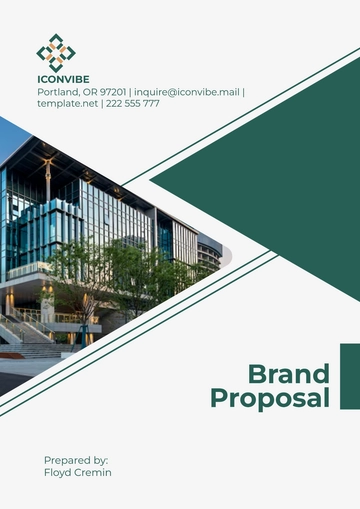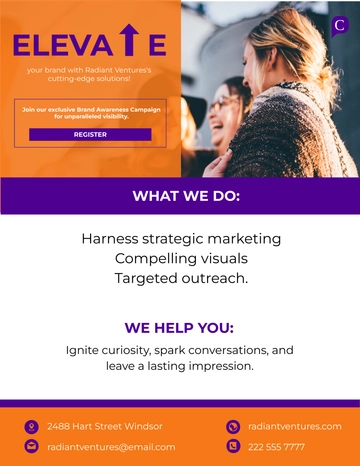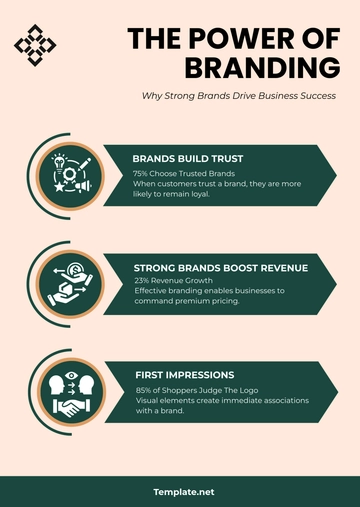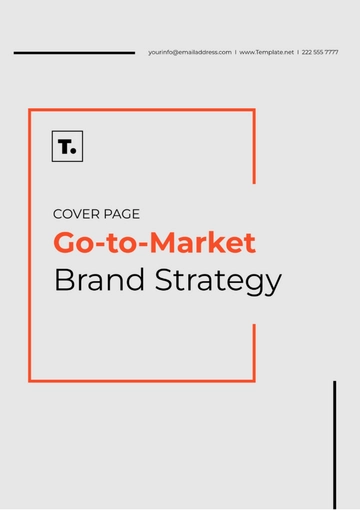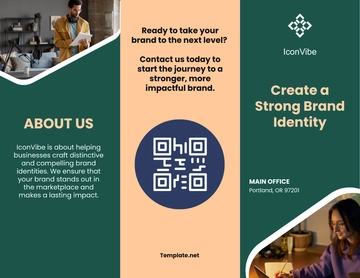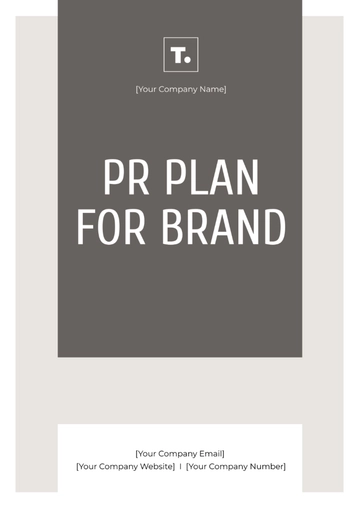Free Brand Communication Advertising Planning Guide
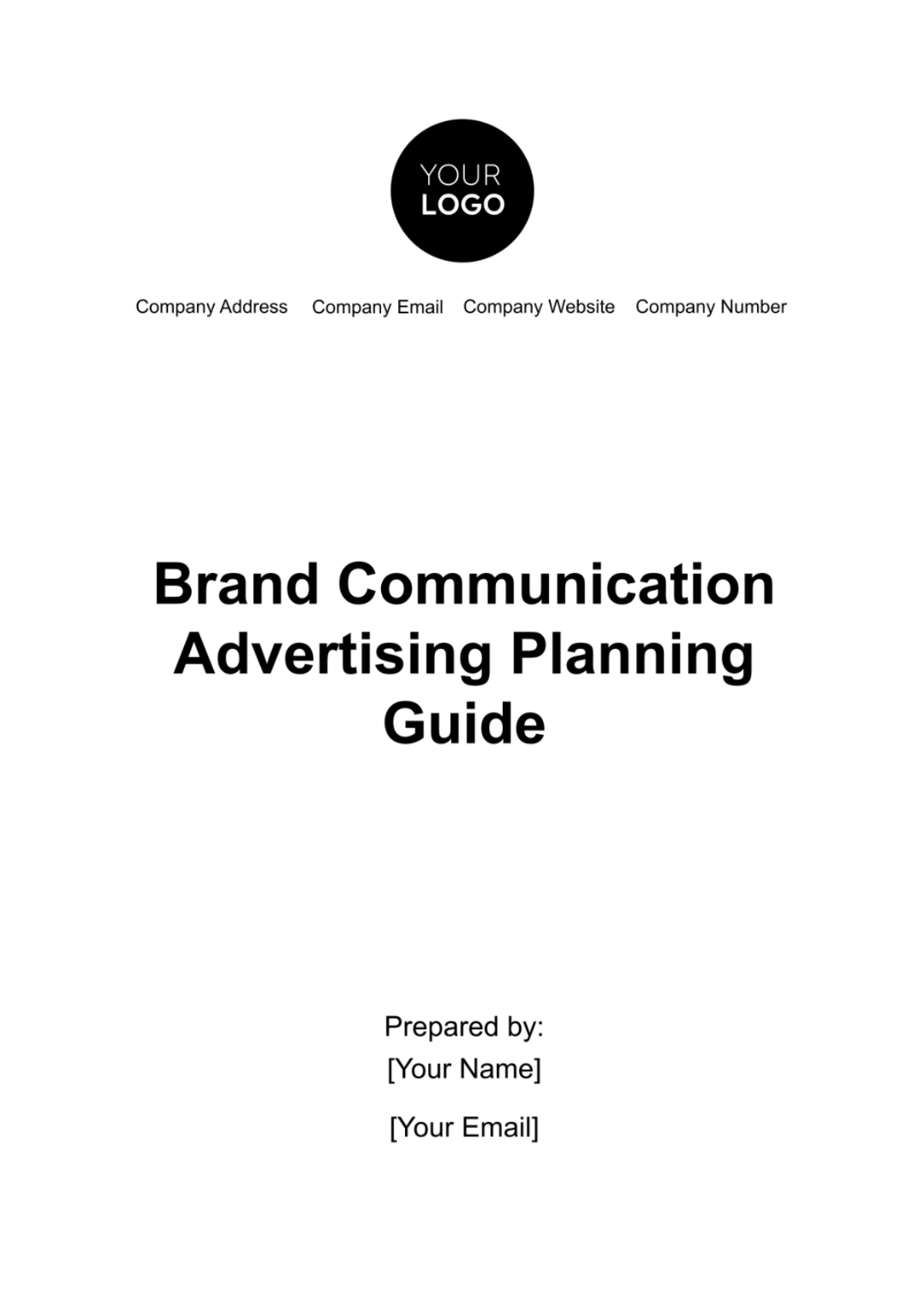
Executive Summary
The clarity of purpose and precisely delineated objectives serve as the guiding principles steering us through the expansive landscape of strategies and tactics. This segment aims to explore the foundational communication objectives that form the bedrock of our advertising endeavors.
A. Definition of Advertising Goals and Objectives
In advertising endeavors lies a clear and ambitious goal: to increase brand awareness for [Your Company Name]'s latest line of eco-friendly products. We aim to achieve this by a substantial 30% within the next quarter.
These objectives are not mere aspirations; they are the cornerstones upon which our advertising plan is built. They provide us with a precise target, a measurable outcome that we strive to attain.
But why does this focus on brand awareness? Research and market analysis has shown that in today's crowded marketplace, a brand's visibility can be the difference between success and obscurity. When consumers are aware of a brand's existence and its offerings, they are more likely to consider it when making purchasing decisions. Therefore, increasing brand awareness is a strategic move to capture the attention of potential customers.
To complement this overarching goal, we have set out specific objectives. One of these is to enhance online engagement. In an era where digital interactions shape consumer perceptions, a strong online presence is indispensable. We seek to foster meaningful connections with our audience through our online channels.
Additionally, we aim to grow our social media follower base. In the age of social networking, a substantial and engaged follower base not only expands our reach but also enhances our credibility and influence within our industry.
B. Alignment with Overall Brand Strategy and Business Goals
Our advertising plan is not a solitary endeavor; it is intricately woven into the broader fabric of our brand strategy and business objectives. At [Your Company Name], we have a long-term vision of becoming a trailblazer in sustainable practices within our industry.
This vision is closely aligned with our advertising objectives. By increasing brand awareness for our eco-friendly products, we are not only elevating our product lines but also reinforcing our commitment to sustainability. We aim to be more than just a company that offers eco-friendly options; we aspire to be a beacon of sustainable excellence in our industry.
Furthermore, these communication objectives are strategically intertwined with our overarching business goal - expanding our market share in the eco-conscious consumer segment. As the demand for sustainable products continues to grow, capturing a larger share of this market is a logical step forward for our brand. Our advertising efforts are meticulously designed to contribute to the realization of this goal.
C. Identification of Key Performance Indicators (KPIs)
Metrics are the barometers of success. To measure the effectiveness of our advertising endeavors, we have identified key performance indicators (KPIs) that will serve as our guiding compass.
Website traffic, for instance, will provide us with valuable insights into the flow of visitors to our online platforms. An increase in website traffic can be a direct indicator of heightened brand awareness and interest.
Social media engagement metrics, such as likes, shares, and comments, will offer a window into the level of interaction and connection we establish with our audience. It is in these interactions that the seeds of brand loyalty are sown.
Lastly, conversion rates from online campaigns will reveal the tangible impact of our advertising efforts on sales and revenue. After all, the ultimate measure of success in the business world is the bottom line.
These brand communication objectives are not mere aspirations. They are well-defined, measurable goals that are strategically aligned with our brand's vision and business objectives. They serve as our guiding stars, ensuring that our advertising efforts are purposeful, impactful, and in sync with our brand's journey toward sustainable excellence.
II. Influencer Selection and Collaboration Overview
Understanding our audience and the market landscape is foundational to crafting a successful advertising campaign. In this section, we will delve into the segmentation of our target audience, glean insights from market trends and consumer behaviors, and assess our competitive landscape for strategic positioning.
A. Segmentation and Profiling of Target Audience
Our target audience is a carefully defined group whose preferences and values align seamlessly with our eco-friendly products. They are individuals aged 25-40 who prioritize sustainability in their purchasing decisions. These consumers are not merely passive observers; they are actively engaged in social media and tend to shop online, making them a digitally-savvy demographic.
To bring this segmentation to life, let's imagine a representative persona, "Eco-Conscious Emily." Emily is a 32-year-old professional who resides in a bustling urban area. She believes in eco-conscious living and actively seeks products that reduce her environmental footprint. She follows sustainable living influencers on Instagram and frequently explores eco-friendly options on e-commerce platforms. Emily's online presence and shopping habits mirror the characteristics of our target audience.
B. Insights into Market Trends and Consumer Behaviors
Market trends are the pulse of the industry, and consumer behaviors are the driving force behind them. Currently, we see a notable trend - a rising demand for eco-friendly products. Consumers are becoming increasingly environmentally conscious, and this shift is reflected in their purchase preferences. The desire to reduce environmental impact has become a powerful driver of purchasing decisions.
Imagine a scenario where research findings reveal that sales of eco-friendly products have grown by 30% in the past year. This growth is not an isolated incident but part of a broader pattern across various industries. Consumers are consciously choosing sustainable options in their quest for a greener lifestyle.
Consumer behaviors, too, tell a compelling story. People are not just buying eco-friendly products; they are seeking brands that genuinely embody sustainability.
This is evident in the rise of consumer activism, with individuals supporting companies that demonstrate a strong commitment to environmental responsibility.
C. Competitive Landscape and Positioning
Understanding our competitors is crucial. We have analyzed the competitive landscape and unearthed valuable insights. While several companies offer eco-friendly products, a significant portion of them lack a robust online presence. This presents us with a unique opportunity - the chance to establish a distinctive position in the digital sphere.
Imagine a competitive analysis that reveals some of our key competitors are traditional brick-and-mortar stores with minimal online visibility. Others may have eco-friendly offerings but have not effectively communicated their commitment to sustainability. This gap in the digital marketplace is where [Your Company Name] can shine.
By leveraging our online presence and emphasizing our eco-friendly product line, we have the potential to stand out and become a go-to destination for environmentally-conscious consumers. This strategic positioning aligns perfectly with our target audience's online habits and their preference for brands that champion sustainability.
This section lays the groundwork for our advertising campaign. It defines our audience, identifies market trends, and positions us strategically in the competitive landscape. Armed with this knowledge, we are well-prepared to craft an advertising strategy that resonates with our eco-conscious target audience and capitalizes on emerging market opportunities.
III. Campaign Strategy and Execution
In advertising, the message is the beating heart of our communication efforts. In this section, we will delve into the intricacies of our message development and creative strategy, ensuring that our voice is both compelling and aligned with our brand identity.
A. Key Messaging Themes and Brand Voice
Every word we choose, every phrase we craft, must resonate with our audience and echo our brand's core values. Our messaging will be rooted in two foundational themes: "Sustainability and Innovation." These themes encapsulate the essence of our eco-friendly products and cutting-edge technology. The brand voice we adopt will strike a balance between being informative and approachable. It will reflect our dedication to environmental preservation and the advanced features of our offerings.
Consider, for instance, crafting messages that emphasize our commitment to sustainability. Phrases like "A Greener Tomorrow Starts Today" and "Pioneering Sustainability Through Innovation" could be part of our messaging arsenal. These slogans exemplify our dedication to environmental responsibility and technological advancement while remaining easily digestible by our target audience.
B. Creative Concept Development
The creative concept we employ plays a pivotal role in captivating our audience's attention. For our campaign, the concept is "Green Living with [Your Company Name]." This concept encapsulates the aspiration of our target audience - to lead environmentally conscious lives without compromising on modern comforts. Visual elements will include natural imagery and colors that mirror the vibrancy of nature. Emotionally, our message will be conveyed through impactful stories of positive environmental change brought about by our products.
Picture a promotional video featuring individuals joyfully interacting with our eco-friendly products, set against the backdrop of lush, green landscapes. These visuals not only align with our sustainability theme but also evoke positive emotions and inspire our audience to envision a greener future.
C. Adaptation Across Different Media and Platforms
In the digital age, our message must be a chameleon, seamlessly adapting to the unique characteristics of each platform. Social media, with its brevity and immediacy, calls for concise and engaging posts that convey our message swiftly. Our website and email campaigns, on the other hand, provide ample space for detailed narratives that can showcase the depth of our brand.
C
onsider crafting a series of social media posts that highlight individual product features and their impact on sustainability. For our website and email campaigns, we can delve deeper into these features, providing in-depth explanations and customer testimonials to build trust.
In conclusion, our message development and creative strategy are the vehicles through which we will convey our brand identity and values to our target audience. By carefully crafting our messages, adopting an appropriate brand voice, and tailoring our content to each platform, we are poised to connect with our audience on a profound level and drive our advertising campaign toward success.
IV. Performance and Impact Analysis
In today's digital landscape, where consumers are inundated with information, effective media planning is the compass that guides our message to the right audience. In this section, we will dive into the intricacies of our media planning and channel selection strategy, ensuring that our efforts are focused, efficient, and aligned with our advertising goals.
A. Identification of Suitable Media Channels
The foundation of our strategy lies in identifying the most suitable media channels to reach our target audience effectively. In the digital realm, we recognize that our audience is highly active and engaged. Therefore, our primary focus will be on digital channels, including:
Social Media: Platforms like Instagram, Facebook, and Twitter, are hubs of activity for our target demographic. |
Search Engine Marketing: Harnessing the power of search engines, we will ensure that our brand and products appear prominently when eco-conscious consumers seek information online. |
Online Display Ads: These strategic placements will allow us to capture the attention of potential customers as they browse the web. |
In addition to digital channels, we will leverage the direct engagement capabilities of email marketing. This approach will allow us to nurture leads, provide personalized content, and maintain a direct line of communication with our audience.
B. Budget Allocation and Media Buying Strategy
Every dollar invested in advertising is a critical resource, and our budget allocation strategy reflects this. Approximately 60% of our budget will be allocated to digital advertising. This substantial portion is a testament to the effectiveness and reach of digital channels, particularly social media and search engine marketing.
The remaining budget will be divided between two key areas:
Email Marketing: A strategic allocation to maintain direct engagement and cultivate relationships with our audience. |
Print Ads: While digital is the primary focus, we recognize the value of print media in reaching certain segments of our audience. As such, we will embark on a limited run of print ads in eco-conscious lifestyle magazines, where our message will find resonance. |
C. Integration of Paid, Owned, and Earned Media
Our strategy is not confined to paid media alone. We understand the significance of a comprehensive approach that integrates paid, owned, and earned media for maximum impact.
Paid Media: This includes our online ads, strategically placed to reach our audience. These advertisements will be highly targeted and designed to capture attention and drive action.
Owned Media: Our website, blog, and email marketing campaigns form our owned media. These platforms will serve as the cornerstone of our content strategy, allowing us to provide valuable information, engage our audience, and foster brand loyalty.
Earned Media: Our message should not only come from us but also from satisfied customers and enthusiastic supporters. We will encourage social media shares and engage in public relations efforts to secure press mentions, further expanding our reach through earned media.
Our media planning and channel selection strategy is a well-balanced orchestration of digital prowess, direct engagement, and a limited yet impactful print presence. By integrating paid, owned, and earned media, we ensure that our message resonates far and wide, guiding our advertising campaign toward success.
V. Insights and Recommendations
In the ever-evolving landscape of advertising, data-driven decision-making is the lighthouse guiding our ship to success. In this section, we delve into the critical aspects of measuring, analyzing, and optimizing our advertising campaign for maximum impact.
A. Methods for Tracking and Measuring Campaign Performance
Understanding how our campaign performs in real-time is vital to make timely adjustments and optimize our strategies. To achieve this, we will employ sophisticated web analytics tools that provide us with a wealth of data. Here's how we'll measure our campaign's performance:
Web Analytics: We will utilize cutting-edge web analytics tools to track various key performance indicators (KPIs). These include website traffic, page views, bounce rates, and conversion rates. By closely monitoring these metrics, we can gauge how effective our digital advertising is at driving potential customers to our online platforms. |
Social Media Analytics: Social media is a powerhouse of engagement and interaction. We will use social media analytics tools to measure engagement metrics like likes, shares, comments, and click-through rates. Additionally, we will track the growth in our social media follower base as a testament to our campaign's success in building an online community. |
B. Analysis of Data and Feedback for Insights
Data, when transformed into insights, becomes the compass guiding our decisions. Regular and thorough analysis of the data we collect is pivotal to understanding what's working and what needs improvement. Here's how we'll harness data for insights:
Monthly Data Analysis: We will conduct in-depth monthly data analysis to gauge the effectiveness of different advertising channels, messaging strategies, and audience segmentation. This ongoing analysis will allow us to make data-driven decisions and pivot our approach when necessary. |
Customer Feedback: Customer feedback is the heartbeat of our campaign. We'll actively gather feedback through social media interactions and online surveys. This valuable input will provide us with a direct line to our audience's thoughts, preferences, and pain points. |
C. Continuous Improvement and Optimization Strategies
Adaptation is the key to longevity in advertising. Our commitment to continuous improvement will ensure that our campaign remains agile and responsive to changing dynamics. Here's how we'll continually optimize our strategies:
Refining Messaging: Based on data and feedback, we will continuously refine our messaging to ensure it resonates with our audience. We'll emphasize what works and adjust or eliminate what doesn't. |
Target Audience Segmentation: As we gather more data on our audience's behavior, we will further segment and tailor our messages to specific groups. This personalized approach will enhance engagement and conversions. |
Channel Strategy Optimization: Not all channels perform equally. By closely monitoring their effectiveness, we'll optimize our channel strategy, allocating resources where they generate the highest returns. |
Budget Allocation Adjustments: As we gather data on which channels deliver the best ROI, we'll make budget allocation adjustments to maximize the impact of our campaign. |
Our approach to measurement, analysis, and optimization is rooted in the understanding that data is the cornerstone of success in modern advertising. By continually adapting our strategies based on data and feedback, we ensure that our campaign remains agile and effective, navigating the seas of advertising with precision and confidence.
- 100% Customizable, free editor
- Access 1 Million+ Templates, photo’s & graphics
- Download or share as a template
- Click and replace photos, graphics, text, backgrounds
- Resize, crop, AI write & more
- Access advanced editor
Introducing the Brand Communication Advertising Planning Guide Template from Template.net. Crafted to streamline your marketing strategy, this editable and customizable tool offers a comprehensive approach to brand communication. Utilize the intuitive Ai Editor Tool to finesse your plans effortlessly. Elevate your campaigns with precision and efficiency.

